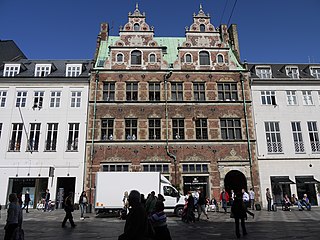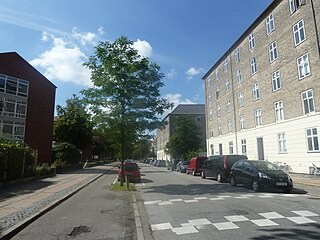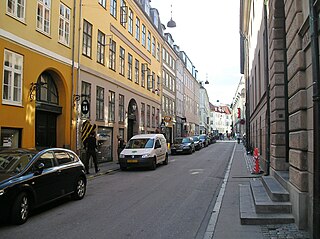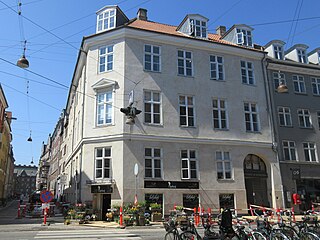Kreditkassen may refer to:

The Copenhagen Fire of 1795 started on Friday, 5 June 1795, at or around 3 pm by the Navy's old base south east of Kongens Nytorv on Gammelholm, in the Navy's magazine for coal and timber, the so-called Dellehave. As the workers had already gone home, a considerable length of time passed before efforts to combat the fire started, and out of fear for theft, the fire hydrants had been removed. The people of Holmen also blocked the civilian fire brigade, possibly in the belief that since it was a military area, the military should take care of it.
Events from the year 1797 in Denmark.
Einar Ambt was a Danish architect.

The Matthias Hansen House, formerly also known as the Schoustrup House is a Renaissance-style townhouse on Amagertorv in central Copenhagen, Denmark. Built in 1616, it is one of few buildings of its kind which has survived the Copenhagen Fires of 1728 and 1795. The building is now home to a flagship store for the Royal Copenhagen porcelain factory.

Kongens Klub was a gentlemen's club founded in 1776 in Copenhagen, Denmark. The club was until the late 1840s based in the Karel van Mander House at Østergade 15. It existed until 1877 when it was merged with Det forenede borgerlige Selskab under the name Kjøbenhavns Klub.

Niels Hemmingsens Gade is a street in the Old Town of Copenhagen, Denmark. It runs from the western part of Amagertorv in the south to Skindergade in the north and passes Gråbrødretorv on the way. The Church of the Holy Ghost is located in the street. The street is named after the 16th-century Lutheran theologian Niels Hemmingsen.

Kjøbenhavns Brandforsikring, founded in 1731, was the first Danish provider of fire insurance in Denmark. It existed as an independent enterprise until 1976 and is now part of Tryg. The company's last headquarters was the Gustmeyer House at Ved Stranden 14 in central Copenhagen.

Laksegade is a street in central Copenhagen, Denmark. It runs from Kongens Nytorv in the northeast to Admiralgade in the southwest from where it continues as Boldhusgade to Ved Stranden.

Sjællandsgade is a street in the Nørrebro district of Copenhagen, Denmark. It runs from Nørrebrogade in the southwest to Tagensvej in the northeast. A short section of the street, between Prinsesse Charlottes Gade and Stevnsgade, has been closed to traffic and is now also known as Guldberg Byplads. It is surrounded by one of two branches of Guldberg School, Simeon's Church and Sjællandsgade Public Baths. The last part of the street follows the northwest side of De Gamles By.

Kattesundet is a side street to the shopping street Strøget in the Old Town of Copenhagen, Denmark. It runs from Vestergade in the northwest to Lavendelstræde-Slutterigade in the southeast, linking Larsbjørnsstræde with Hestemøllestræde. The buildings that line the southwest side of the street all date from the years after the Copenhagen Fire of 1795. Six of them, No. 2 and No. 10-18, are listed in the Danish registry of protected buildings and places. The other side of the street is dominated by the rear side of Copenhagen Court House and the Anton Rosen Jugendstil Metropol Building from 1908.
Frantz Philip Nicolai Lange was a Danish architect and master mason. He made a significant contribution to the rebuilding of Copenhagen in the years after the Copenhagen Fire of 1795. Most of his buildings have been listed on the Danish registry of protected buildings and places.

Mikkel Bryggers Gade is a pedestrianized street in the Old Town of Copenhagen, Denmark. It runs from Frederiksberggade in the north to Lavendelstræde in the south. The art cinema Grand Teatret is located in the street. It is based in the large Palace Hotel complex.

Thomas Andreas Blom was a Danish master mason, architect and developer who contributed to the rebuilding of Copenhagen in the years after the Copenhagen Fire of 1795 and the Battle of Copenhagen in 1807. He initially worked in a partnership with his mother and three brothers as Bloms Enke & Sønner, constructing approximately one building per year between 1799 and 1808. After being licensed as a master mason in 1810, he continued the work independently. Most of his surviving buildings are listed on the Danish registry of protected buildings and places. He was also active in Copenhagen Fire Corps, reaching the rank of deputy fire chief. He was a driving force behind the foundation of Håndværkerstiftelsen as a charity providing affordable accommodation for old craftsmen and their widows in difficult circumstances.

Højbro Plads 13 is a Neoclassical property situated at the corner of Højbro Plads and Lille Kirkestræde in central Copenhagen, Denmark. The building was like most of the other buildings in the area constructed as part of the rebuilding of the city following the Copenhagen Fire of 1795. It was listed in the Danish registry of protected buildings and places in 1950.

Laksegade 26 is a Neoclassical property situated at the corner of Laksegade and Nikolajgade in central Copenhagen, Denmark. It was listed in the Danish registry of protected buildings and places in 1939. A plaque on the facade towards Laksegade commemorates that the architect Theophilus Hansen was born in the building.

Fortunstræde 1 is a Neoclassical property situated at the corner of Fortunstræde and Admiralgade, opposite the former St. Nicolas' Church, now Kunsthallen Nikolaj, in central Copenhagen, Denmark. The building was like most of the other buildings in the area constructed after the Copenhagen Fire of 1795. It was shortly thereafter acquired by the bookseller Abraham Soldin who in partnership with his brother Salomon Soldin ran a bookshop and publishing business from the premises. The venture was later continued by his son Ferdinand Vilhelm Soldenfeldt as F. V. Soldenfeldt. The building is today owned by Borgervennen, a fraternal society founded in 1788, now based in the apartment on the first floor. The building was listed in the Danish registry of protected buildings and places in 1945.
Lauritz Laurberg Thrane (1757–1809) was a Danish master mason architect and builder. He was one of the most active master builders in Copenhagen during the 1790s and 1800s, contributing to the rebuilding of the city following the Copenhagen Fire of 1795. Many of his surviving buildings have been added to the Danish registry of protected buildings and places.

Admiralgade 25/Laksegade 32 is a Neoclassical property situated at the corner of Admiralgade and Laksegade in central Copenhagen, Denmark. It was constructed for goldsmith Christian Nielsen Lindbach after his previous building on the site had been destroyed in the Copenhagen Fire of 1795. It was listed in the Danish registry of protected buildings and places in 1939.

Rådhusstræde 6 is a Neoclassical property situated at the corner of Rådhusstræde and Kompagnistræde, betweenGammeltorv-Nytorv and Gammel Strand, in the Old Town of Copenhagen, Denmark. It was constructed by Andreas Hallander, one of the most active master builders in the rebuilding of the city following the Copenhagen Fire of 1795.The building was listed in the Danish registry of protected buildings and places in 1964. Notable former residents include the politicians Johan Nicolai Madvig and J.A. Hansen. Later acquired by the Danish Union of Teachers, it housed the Danish School Museum from 1995 to 2008.















